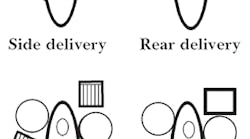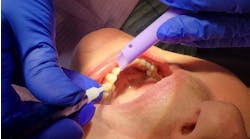By Betty Ladley Finkbeiner and Michael Muscari
Ergonomics is often written about and many dental professionals think they are practicing the concepts of ergonomics in their daily office activities. However, ergonomics - the science that studies the relationship between people and their work environment - often falls short when a dental staff chooses equipment for the dental treatment room to practice true four-handed dentistry. Thus, it behooves the reader to take advantage of the research that documents the true principles of four-handed dentistry and to evaluate the decision to purchase specific equipment for long-term use with a set of criteria that meets the goals of true four-handed dentistry.
The clinical dynamics of four-handed dentistry include the process of a skilled operator and assistant working together in a safe, stress-free, productive ergonomic environment. In the hands of a skilled dental team, this combination ensures stress reduction, increased productivity, maximum organization, improved efficiency, and increased profit.
Any dental professional will tell you that sitting at chairside all day is very uncomfortable and often results in lower back pain, tendonitis, and/or neuromuscular or musculoskeletal complications. The current generation of dentists knows little about the concept known as four-handed dentistry, since it is not taught in most dental schools today. Those educators who learned this concept in the 1960s and 1970s have left the classroom or have moved on to administrative positions in dental school and are no longer teaching four-handed dentistry in the clinical environment.
Most graduates from dental schools are learning bits and pieces of these concepts from others who have discovered a few of them on the job or from graduates of accredited dental assisting programs. This article is written for team members who are faced with undue stress due to poorly designed facilities and incomplete knowledge. It also offers suggestions for all team members that will make a positive difference in your work strategies.
Basic tenets of true four-handed dentistry
Many dentists and assistants believe they practice four-handed dentistry, yet still suffer the results of physical stress due to the use of inappropriate equipment and techniques that fall short of meeting the basic tenets of four-handed dentistry.
Dentists can still be observed changing their own burs, twisting and turning to reach equipment on their sides of the chair. If the assistant is not in charge of all instrument transfers and the equipment is not within his or her reach, true four-handed dentistry is not being practiced and many key benefits and advantages are unknowingly forfeited. You might ask, “When the dentist is doing the assistant’s work, who is doing the dentist’s work?”
- Equipment must be designed to minimize unnecessary motion
- The operating team and patient are seated comfortably in ergonomically designed equipment
- The dentist assigns all legally delegable duties to qualified dental professionals based on the state’s guidelines
- Patient treatment is planned in advance in a logical sequence
- The patient is placed in supine position
- Motion economy is practice
- Preset trays are utilized
- Participatory ergonomics are practiced
True four-handed dentistry is not “hurry-up dentistry.” It is based on a set of principles that define the conditions under which efficiency can be attained. These principles are shown in figure 1.
Evaluating equipment designs
The box at right contains schematic examples of the four common unit styles. Applying these criteria to several popular designs will help you determine the benefits of modifying and upgrading your clinical facility.
The basic dental unit designs available today include the transthorax, side delivery, rear delivery, and split unit/cart (see figures at right). An often-overlooked factor when choosing a dental unit is that the assistant should be the primary focus.
Transthorax unit
This unit design meets the requirements of time and motion concepts and promotes good ergonomic positioning. With the unit over the patient’s thoracic area, the assistant can easily retrieve the handpieces and transfer them to the doctor who does not need to remove his or her eyes from the operating site. The Alabama Mobile Cabinet with a front-to-back moveable top that comes over the assistant’s lap acts as the major supply cabinet, housing all of the instruments within an easy, nonstressful reach. The North Carolina version of this cabinet allows the top to move left to right and be positioned over the assistant’s legs. There are no hoses to interfere with the assistant’s position. This type of unit has been designed for the practice of true four-handed dentistry. HSP manufactures the only transthorax unit available.
Side delivery
This unit has been a popular concept for many decades. In fact, most schools use this style of unit, often supplied with a bracket tray. This unit requires the dentist to pick up the handpieces, which forces him or her to remove his or her eyes from the treatment site, twist and turn to grasp the instrument, and then refocus. This results in stress and fatigue. The assistant can’t reach the instruments to exchange handpieces or change burs, reducing productivity. Often in this set-up, high-velocity evacuation is located on the assistant’s side of the chair that pushes the assistant away from the chair. At times, HVE hoses are located on the mobile cart. The concern here should be whether the addition of the hoses to this cart has diminished its effectiveness. Does it still have a mobile top and adequate storage that is not impeded by the hoses?
Rear delivery
The doctor must pick up the handpieces, which requires severe twisting and turning, as well as eye strain, since the doctor is forced to turn from the operating field to pick up the handpiece. Often it is necessary to transfer the handpiece from the retrieval hand to the operating hand. The units are mounted in a fixed position that cannot be moved to accommodate for the positions of the dentist or for ease of use for the assistant. HVE hosing and air/water syringes are permanently affixed to an assistant’s work area. Since it is in the rear, it requires that the assistant lean forward. When a mobile cart is used with this concept, it may interfere with access to the sink or to the HVE and air/water syringe. For the assistant, this can provide undue stress and strain and limit access for increased productivity.
Split unit/cart
This concept places part of the dental unit on the operator’s side and the HVE and air/water syringe on the assistant’s mobile cabinet. As in the side delivery unit, it requires the dentist to grasp the handpieces and makes them inaccessible to the assistant, thus reducing productivity. The assistant can only use the HVE and the air/water syringe that are attached to the mobile cabinet and is unable to transfer handpieces or change burs. Often mobile cabinets used in this concept are not designed to contain back-up instruments and adequate storage for materials. The split unit design can limit the assistant’s working space and requires that back-up instruments be placed in tubs on the fixed cabinetry. This position requires additional motion to retrieve needed instruments and materials and opens the door to cross-contamination of instruments stored in the tubs.
Equipment selection
Selection of equipment for use in four-handed dentistry is integral to its success. Over the years, many manufacturers have attempted to meet the criteria and failed. Some of the original research done at the University of Alabama School of Dentistry during the evolution of four-handed dentistry resulted in equipment now being manufactured by Health Science Products, Inc.
The team cannot successfully practice four-handed dentistry if members must reach for instrumentation, become entangled in an array of cords, or are unable to comfortably reach the patient. You need only walk onto a convention floor to see a myriad of equipment that causes the dental team to become confused and this equipment can result in undue stress when used.
Alan Hedge, Ph.D., Professor, Department of Design and Environmental Analysis, in the College of Human Ecology, notes that the consumer should learn how to judge the ergonomic design of a product. He lists the following suggestions:
- Does the design of the product make intuitive sense given the goal of the design?
- Does the product feel comfortable to use?
- Does the product put the user into a more neutral posture?
- Can the manufacturer/designer clearly articulate what the ergonomic objectives are for specific design elements? In other words, why is the product designed this way?
- Does the manufacturer have any research evidence to demonstrate that their product works? How good is the evidence? Is it undertaken by reputable external bodies? What published evidence is there that the product works?
- Can the manufacturer give contacts for others already using the product?
- If you are still in doubt and if it is appropriate, is the manufacturer willing to let you have a 30-day trial period using the equipment or allow you to visit their design studio to work with the equipment?
Criteria for equipment selection
Before purchasing equipment, the dentist and team members must realize this is a long-term investment that must ensure good ergonomics and safe practice. Asking the following questions when selecting equipment will lead you toward the first steps in creating an ergonomically sound practice. If the answer is “no” to any of these factors, the search for equipment should continue.
Dental unit
- Is it a transthorax style?
- Does it adjust vertically and have a horizontal tilt for easy access to operator and assistant?
- Does it have smooth tubing that is tangle-free, off the floor, and gravity retractable?
- Is it able to withstand rigorous daily use?
- Does it have zero suckback?
- Does it allow a second handpiece or other instrument to be available for transfer without being activated?
- Is it designed to contain multiple handpieces and high-technology devices?
- Is it free of a bracket table and cuspidor?
- Is it free of multiple foot controls because the instruments managed from the unit can be integrated into one rheostat?
Dental unit components, including air/water syringe, handpieces, HVE system, air/water or air-only syringes (standard or proprietary), air and electric handpieces (with and without fiber optics), piezo scaler or ultrasonic, electrosurge, and other instruments that require air, water, electricity, or some combination.
- Do each of these components contain lightweight, smooth, flexible hosing?
- Are they easy to use?
- Are there fiber optic options?
- Can they be easily positioned so that the assistant can readily pass them to the operator without infringing on the patient?
- Are the attachments to the hoses sterilizable?
- Do the handpieces provide a range of speeds and locking mechanisms for hoses to prevent tugback?
- Does the air/water syringe retain an angled tip that is easily rotated?
Mobile cabinet
- Is it stable and easy to move?
- Does it provide easy access to instruments and materials?
- Is there adequate work surface within 1 to 2 inches of the elbow?
- Does it provide a movable work surface that can be positioned over the assistant’s lap or knees?
- Does it provide adequate storage?
Patient chair
- Does it have a thin, narrow back with a concave seat and lower lumbar support?
- Is it free of wide wings that prohibit the assistant and operator from being seated close to the patient?
- Does it provide a programmable, automatic, preset positioner that places the patient in supine position?
- Is it free of protrusive devices on the back?
- Does it provide neck and head support for the patient?
- Is it capable of being positioned for right- or left-handed operators?
- Is it easily cleanable and free of fabric upholstery?
Dental stools
- Do they provide a stable base with four or five casters?
- Do they have well-padded flat or contoured seats?
- Are they easily adjustable?
- Does the assistant’s stool provide back and abdominal support that adjusts vertically and horizontally?
- Does the operator’s stool provide vertical and horizontal adjustment with back support?
Fixed cabinetry
- Can it be kept to a minimum?
- Can it be positioned to provide for maximum floor space?
- Can it be positioned so the assistant can easily gain access to backup materials as needed? The 12 o’clock position is good for this location.
- Is a section of it located far enough away to avoid infectious aerosols coming in contact with records and radiographs?
Conclusion
True four-handed dentistry - the process of the dental team implementing time and motion principles and using ergonomic equipment, with all four hands working together throughout the treatment procedure - is the only way to reduce stress and increase productivity. The common adage that everything old is new again leads the professional to reference the intensive research done by the federal government in earlier decades to recognize what experienced practitioners have already proven. True four-handed dentistry requires that appropriate techniques be followed for seating the patient and the operating team, instrument transfer, oral evacuation, infection control, and that, during all of these procedures, concern be given to conserving motion and not just adding people and hands to the operatory. It also requires that the selection of equipment be based on the assistant’s domain and good ergonomic practice. It is here that the fundamentals of transthoracic equipment are even more compelling to the practice of true four-handed dentistry. The dental profession cannot continue to work with equipment designed without concern for productivity and stress-reduction.
The assistant and dentist must work as a team, in practice as well as in the design of a safe, ergonomically sound working environment. This is even more important as the profession integrates loupes, microscopes, and monitor-based systems that magnify and illuminate simultaneously while maintaining the dentist’s complete focus on the operating field. In turn the dentist must delegate expanded duties and capitalize on the organizational skills of the professional assistant who actually becomes a profit center to the practice.
The next time you are uncomfortable after a day’s work, consider remodeling or building a new office, or when visiting a convention floor seeking new equipment, ask yourself how wise you are about the ergonomics of the dental equipment you are considering!
Editor’s note: References available upon request.
Betty Ladley Finkbeiner, CDA, RDA, MS is a graduate of the University of Michigan School of Education. She is an emeritus faculty at Washtenaw Community College, Ann Arbor, Mich., where she served as chairperson of the Dental Assistant Program for 36 years. She has authored articles in professional journals and co-authored several textbooks. She can be reached by e-mail at [email protected]. Michael Muscari is senior vice president of Health Science Products, Inc., in Birmingham, Ala. He can be reached by e-mail at [email protected] or by phone at (800) 237-5794.







